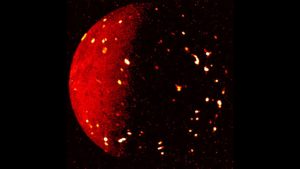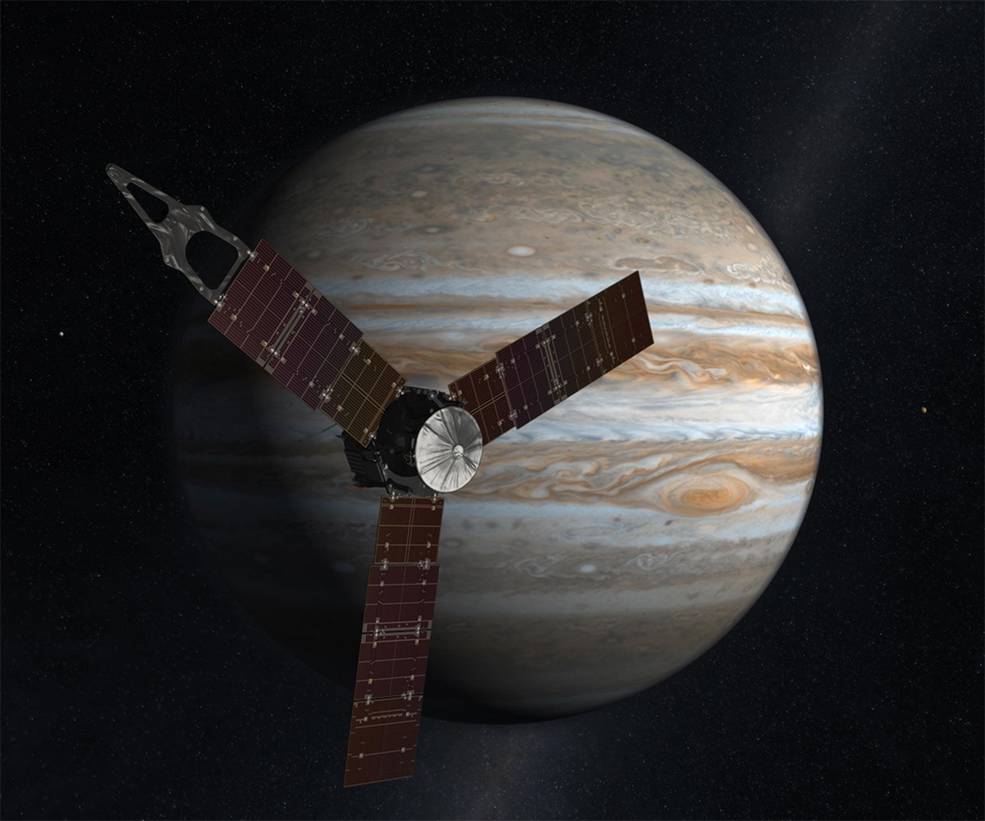Juno at Jupiter
Jupiter is now setting ever earlier in the west
The bright planet has been a beacon in our sky for months.
As we viewed Jupiter from Earth, a space probe has been orbiting the giant world.
The spacecraft is NASA’s Juno.

Space probe Juno. Image: NASA
We’ll take a look at some of its amazing images and review its findings.
The Mission
Timeline
- Launch – August 5, 2011
- Earth flyby gravity assist – October 2013
- Jupiter arrival – July 2016
- Extended Mission – August 2021
- End of Mission – September 2025
Journey
Juno was launched on August 5th, 2011 from Cape Canaveral.
It was one of the New Frontiers space probes.
Juno’s prime aim was to study the atmosphere of Jupiter.
This would tell us more about the origins and evolution of Jupiter.
In turn, we would learn more about the origin of the Solar System and planetary systems elsewhere.
The mission is particularly well named.
In Greek and Roman mythology, Jupiter drew a veil of clouds around himself to hide his mischief.
Jupiter’s wife, the goddess Juno, was able to peer through the clouds and reveal Jupiter’s true nature
After a five-year journey, he spacecraft arrived at Jupiter on July 6th, 2016.
It was a scary ride.
As Juno approached Jupiter, the planet’s gravity increased its speed to a phenomenal 130,000 mph.
A 35 minute slowed the craft and it went into an elliptical orbit.
This would take it over the poles, with a single orbit time of around 53 days.
Images
Before we look at Juno’s findings, we’ll enjoy some of its amazing images.
Jupiter Marble

Jupiter globe. Credit: NASA/JPL
Our first image shows the Jupiter marble.
Standing out is the great red spot, a storm that has blown for hundreds of years.
We see pale storms, hurricanes stirring the gas clouds.
And we get a glimpse of the turbulence in the thick atmosphere.
Swirling Clouds
Our second image shows part of the north temperate belt.

North Temperate Belt of Jupiter. NASA/JPL
This image shows swirling clouds and storms.
The gas is acting like a liquid, carrying flows of vapour in the currents.
Jovian Vortex
Our third image shows a cyclonic storm on Jupiter.

Jovian Vortex. NASA/JPL
I chose this image because it resembles satellite images of hurricanes on Earth.
The eye of the hurricane seems to plunge deep into the planet.
Deep Motion
On its 24th flyby, Juno took this image of the northern hemisphere, toward the north pole.

Deep Motion. NASA/JPL
This turbulent region is pockmarked with storms and violent flows of gas.
Moonshadow
Juno captured this dramatic image showing moon Io’s shadow on the clouds.

Io shadow. NASA/JPL
Io is Jupiter’s innermost Galilean moon and the the third biggest.
Io is covered in volcanoes, some of them taller than Mount Everest.
As Io moved between the Sun and Jupiter, it cast this crisp shadow on the clouds.
Great Red Spot
We couldn’t leave out Jupiter’s most famous feature.

Great Red Spot. NASA/JPL
In this image the red spot looks benign, almost serene.
But this anti-cyclonic storm twists with winds of over 250 mph.
South Pole
Our final image shows the south pole of Jupiter.

Jupiter South Pole. NASA/JPL
Juno saw Jupiter’s south pole from a distance of 32,000 miles, 52,000km.
The oval features are storms some 600 miles across, 1000km.
Moons
Juno has also taken images of Jupiter’s moons.
This was really a mission bonus, as Jupiter was the primary target.
Io
Juno’s infra-red camera captured this striking view of Io.
This is the moon whose shadow Juno also saw.

Io from Juno in infra-red. NASA/JPL-Caltech/SwRI/ASI/INAF/JIRAM
The image shows scores of hotspots associated with Io’s many volcanoes.
Europa
Europa is the smallest of the Galilean Moons but possibly the most intriguing.

Juno images Europa. NASA/JPL
Below the thick icy surface of Europa, there may be an ocean of water.
That water may possibly be home to alien life.
Juno’s Findings
The data from Juno is still being analysed and will be for some time.
Early results may challenge our current ideas.
The dark bands and zones that we see from Earth extend hundreds of miles into the atmosphere.
They indicate that the interior isn’t evenly mixed.
One hypothesis from this is that Jupiter does not have a rocky core, as previously thought.
Instead the core is a mixture of rock and metallic hydrogen.
Juno’s Future
Juno was designed to complete its mission in 2018, after 32 orbits.
NASA has extended the mission to September 2025.
It will then be sent into Jupiter’s atmosphere and burn up.
This will prevent a future crash into a Jovian Moon and the risk of contaminating another world.
Juno’s Passengers
The spacecraft carries a plaque featuring astronomer Galileo Galilei.

Galileo plaque aboard Juno. NASA/JPL-Caltech/KSC
In 1610 Galileo was the first person to observe and record the four great moons of Jupiter.
The craft also carries Lego figures of Galileo, Jupiter and Juno.
This is part of a outreach programme to interest children in science, technology, engineering and maths.
More Juno
To find out more about Juno, please look at NASA’s website.
Just click JUNO.
The author: Dennis Ashton is a Fellow of the Royal Astronomical Society and a Wonderdome presenter.
Would you like to hear more Astronomy news?
Do you want to to find out about our upcoming public events?
Follow WonderDome Portable Planetarium on Twitter and Facebook or go to our web site wonderdome.co.uk

